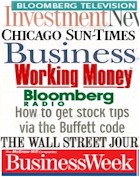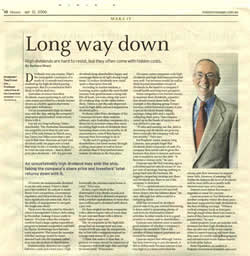Just
ask any long-suffering Telstra shareholder. The Australian
sharemarket has surged by more than 85 per cent since
it hit rock bottom in March 2003, but Telstra has fallen
more than 7 per cent in that time. Not even an 8 per cent
dividend yield can paper over a crack that wide. In the
12 months to March 31, its total one-year return - that
is, share price plus dividends - fell 18.9 per cent.
Of
course, an unsustainable dividend is not the only reason
Telstra's share price has tumbled. Its outlook is under
threat from competition, Government regulation and full
privatisation. It also faces significant execution risk,
that is, the ability of management to navigate the rough
seas ahead.
These
were the risks cited by Moody's when it downgraded Telstra's
debt rating in December, making it more costly to borrow.
At a time when the company needs to fund a large capital
expenditure program to remain competitive and fulfil its
charter, borrowings have become more expensive. This raises
the question whether earnings would be better directed
back into the business rather than into the pockets of
shareholders.
Unfortunately,
directors are caught between a rock and a hard place.
High dividends keep shareholders happy and encourage them
to sit tight during tough times. To reduce dividends now
could spark a share-price free fall.
According
to market wisdom, a booming market makes the most foolish
investor look good because a rising tide lifts all boats,
yet even a king tide won't lift a leaking ship. As the
tables below show, Telstra is not the only shipwreck sunk
by high debts and an overgenerous dividend policy.
Professor
John Price, developer of the Conscious Investor share
analysis software, says Australian companies do a disservice
to investors when they insist on setting high levels of
dividends then increasing them every six months in all
circumstances, even if they have to increase their borrowings
to do it.
"In
the end it's going to cost shareholders a lot more money
through a falling share price as well as lower dividends
than if they received more realistic dividends in the
first place. Eventually the chickens come home to roost,"
Price says.
In
fact, a spot check of the sharemarket's top chooks reveals
just that. Price looked at all listed companies with a
market capitalisation of more than $500 million and a
dividend yield above 5 per cent. He then singled out those
companies with a debt-to-equity ratio of more than 80
per cent and those with a debt-to-equity below 40 per
cent.
The
18 companies in the high-debt group had an average total
one-year return of 6.88 per cent. By comparison, the 16
low-debt companies enjoyed an average total return of
15 per cent. "I think this makes it clear that, in
general, investors should be suspicious of companies with
both high debt and high dividend yield," Price warns.
Of
course, some companies with high dividends and high debt
have performed very well. Yet investors would do well
to think beyond immediate reward of dividends in the hand
to a company's overall health and long-term prospects.
Some companies even borrow money to maintain their dividends,
a practice that should sound alarm bells. One example
is the cleaning group Tempo Services, which borrowed money
to pay a special dividend despite falling earnings, rising
debt and a rapidly collapsing share price. The company
ended up in the hands of receivers and was delisted a
year ago.
"If
sales and earnings are flat, debt is increasing and dividends
are growing then eventually the company will run into
trouble," Price says.
Fat
Prophets' senior analyst, Greg Canavan, says people forget
that dividends drain companies of cash. If a company then
needs cash to grow the business they have to borrow and
more cash is needed to service the debt. "It becomes
a vicious cycle," he says. Canavan
says the first warning sign is a dividend payout ratio
in excess of 100 per cent of earnings, leaving nothing
to pump back into the business. He suggests comparing
earnings per share and dividends per share to see if the
company is stretched.
"If
it's a capital-intensive business you need to be a little
concerned and drill down deeper into the balance sheet,"
he says, although low debts could be a mitigating factor.
AMP
has increased its dividend payout ratio to 85 per cent
but borrowing is down and it is generating plenty of cash
from its sharemarket-related activities. In other words,
it is in a good position to return cash to shareholders.
Canavan says interest cover is another good measure of
whether a company's finances are stretched. This is the
number of times interest payments are covered by earnings.
Canavan
argues that although Telstra has been borrowing to pay
dividends, it did so deliberately because interest cover
was high at 9.5 times and it had the strong cash flow
necessary to support more debt. However, if earnings fall
further he believes the level of dividends will be more
difficult to justify with interest cover now at 6.5 times.
Interest cover below five times is regarded as cause for
concern.
Canavan
points to Ten Network as another company where the share
price has been supported by high dividends in the face
of falling earnings. "When a cyclical company [such
as Ten] goes through tough times there's no room to move
if they have an 80-90 per cent payout ratio," he
says.
Listed
property trusts are popular with investors for their high
dividends but they are also one of the worst culprits
when it comes to paying out more than they earn. It's
worth noting that property and infrastructure trusts feature
heavily in both tables below.
Peter
Papadakos, an analyst at Property Investment Research,
says over the past 12 months the trend has been to reduce
payout ratios to below 100 per cent although listed trusts
must distribute more than 90 per cent of profits to be
exempt from tax at the corporate level.
Papadakos
says companies now realise the market will hammer their
share price if they pay out more than they earn. The property
cycle may also be behind moves to reduce distributions
as companies try to build up reserves.
Price
argues that Australian companies have failed to educate
investors about what constitutes a sensible dividend policy.
Too often directors use dividends as a public relations
exercise for short-term share price gains. "Directors'
business is not to sell themselves to shareholders but
to run their business as best they can," says Price.
When
sales are not growing Price says directors should say
it would be better to lower dividends in the short term
because they need to keep cash to build the business.
Investors often say they need dividends to live on but
Price argues that money is money and wealth grows through
a combination of capital gains and dividends. While dividends
offer the tax benefits of dividend imputation, capital
gains also benefit from the 50 per cent capital gains
tax discount for shares held for more than a year.
Price
believes investors would be better off selecting quality
companies and selling a few shares when they need the
cash. "If a share price goes up 15 per cent a year
and you only sell 5 per cent of your shares you are still
growing in wealth. A company with a 6 per cent dividend
yield and no growth is worse than one with a 2 per cent
yield and capital growth of 15 per cent," he says.
The analysis carried out by Price contained one more surprise.
The
high and low debt companies in the lists below were taken
from a total of 244 companies with a market capitalisation
of more than $500 million. The average 12-month total
return for all 244 companies was a remarkable 42.6 per
cent, compared with 6.88 per cent for the high-dividend,
high-debt group and 15 per cent for the high-dividend,
low-debt group.
That
is, over the past year, high-dividend-paying companies
performed worse on average than low payers. Or as Price
puts it, dividends cost you money.
John
Price is CEO of Conscious Investing. Email: johnprice@conscious-investor.com



